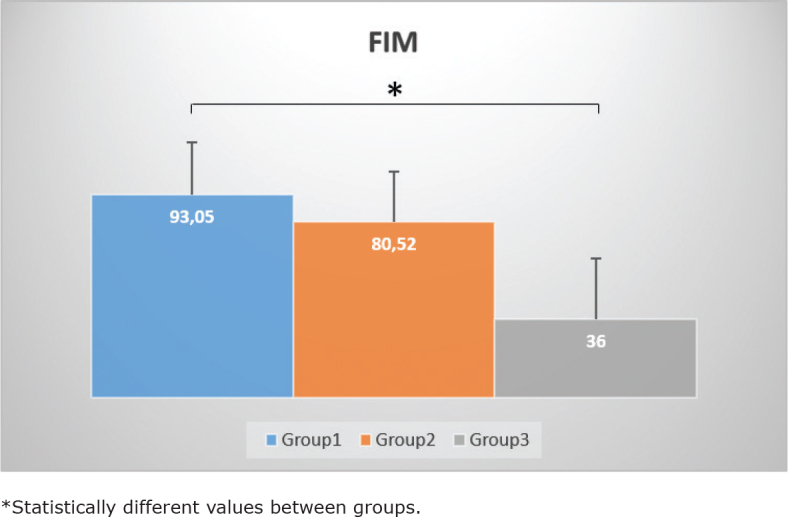SARCOPENIA IS A FREQUENT DISEASE IN SARS-COV-2 INFECTION.
Journal of rehabilitation medicine. Clinical communications
Pub Date : 2023-01-01
DOI:10.2340/jrmcc.v6.2222
引用次数: 0
Abstract
Objective We aimed to investigate the clinical symptoms and specific care requirements of SARS-CoV-2 patients who were admitted to a COVID-19 Rehabilitation Unit while still infectious for SARS-CoV-2 and in the subacute phase of the disease. Methods Patients admitted to our COVID-19 Rehabilitation Unit from March 2020 to December 2020 were evaluated for sarcopenia, and they also completed the following assessments: functional independence measure, short physical performance battery and Hamilton Rating Scale for Depression. Age and body mass index and symptoms of dysosmia or dysgeusia were also recorded. Results A total of 126 patients were enrolled (50 women, median age 72 years, 18.7 years), of whom 82% of patients presented with low grip strength. Sarcopenia was diagnosed in 52 patients. Sarcopenic patients were older than non-sarcopenic ones (median age 73.4 years, IQR 13.2 vs 63.9 years, IQR 14.5, respectively, p = 0.014). Sarcopenia was associated with the presence of depression (p = 0.008), was more common in women (p = 0.023) and was associated with greater functional deficits (functional independence measure and short physical performance battery analyses, p < 0.05). Sarcopenic patients also had a lower body mass index than other patients (p < 0.01). Conclusion More than 40% of our patients suffered from sarcopenia, which was associated with ageing, depression, low body mass index, reduction in functional autonomy and being a woman. Such data provide evidence for the need to assist hospitalized COVID-19 patients by means of a multidisciplinary specialist team. LAY ABSTRACT Many COVID-19 patients who require hospitalization in the first phase of the disease benefit from respiratory, motor or cognitive rehabilitation before being dismissed from the hospital. During this rehabilitative phase, these patients are still positive for SARS-CoV-2 and potentially infectious, although their symptoms might differ from the symptoms they encountered in the first days. The objective of this study was to examine the clinical condition of 126 COVID-19 patients in a COVID-19 rehabilitation ward. Our data demonstrated that 41% of these patients presented with sarcopenia, which represents a drastic loss of muscle mass. We noticed that the risk factors associated with sarcopenia were ageing, depression, being a woman and having more issues with being independent in daily life. These results reveal the importance of providing such COVID-19 patients with specific care by multidisciplinary teams of healthcare professionals.

肌肉减少症是sars-cov-2感染的常见病。
目的:了解仍具有传染性且处于亚急性期的SARS-CoV-2患者入住COVID-19康复病房的临床症状和特殊护理要求。方法:对2020年3月至2020年12月入住我院康复科的患者进行肌肉减少症评估,并完成以下评估:功能独立性测试、短体能测试和汉密尔顿抑郁评定量表。年龄和体重指数以及嗅觉障碍或发音障碍的症状也被记录。结果:共纳入126例患者(女性50例,中位年龄72岁,18.7岁),其中82%的患者表现为握力低。52例患者被诊断为肌肉减少症。肌少症患者年龄大于非肌少症患者(中位年龄73.4岁,IQR分别为13.2 vs 63.9岁,IQR为14.5,p = 0.014)。肌肉减少症与抑郁症的存在相关(p = 0.008),在女性中更为常见(p = 0.023),并与更大的功能缺陷相关(功能独立性测量和短时间物理性能电池分析,p < 0.05)。肌少症患者的身体质量指数也低于其他患者(p < 0.01)。结论:超过40%的患者患有肌肉减少症,这与衰老、抑郁、低体重指数、功能自主性下降和女性有关。这些数据为需要通过多学科专家团队协助住院的COVID-19患者提供了证据。
本文章由计算机程序翻译,如有差异,请以英文原文为准。
求助全文
约1分钟内获得全文
求助全文

 求助内容:
求助内容: 应助结果提醒方式:
应助结果提醒方式:


